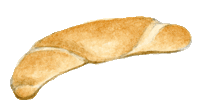Rohlik

Form: Crescent-shaped with pointed tips
Country of origin: Czech Republic
What distinguishes it from other methods of bread making: Dough contains fat and sugar
Category of bread: (8) Similar to an Italian cornetto, Austrian kipferl, and French croissant
Particularity: Mainly used for sandwiches
Ingredients: T55 high-gluten flour; eggs; fat; baker’s yeast; salt; sugar

Czech Republic
It is undoubtedly impossible to dissociate the history of Czech rohlik from that of the Austrian kipferl. They are both crescent-shaped, and at least one of the two, the kipferl, is considered the ancestor of the French croissant. The inspiration for the historical fact behind them lies in the reinterpretation by Viennese bakers of quite another event. Thanks to Viennese bakers’ vigilance (since they work at night-time), it might just have been them who gave the alert just in time to make it possible to thwart the Turkish army’s plans to lay siege to Vienna in 1683. In remembrance of this event, the bakers borrowed the idea and shape of the crescent from the Turkish flag. It is this “crescent” that Christophe Auguste Zang must have brought in his baggage when he came to Paris to open a bakery, the Boulangerie Viennoise on the rue de Richelieu in Paris (1838-1839).
It makes a nice story, but some historians like to remind us that it already existed in Parma, Italy, at the beginning of the 19th century in the form of cornetti and also in the form of calzone, a crescent-shaped pizza. So the Austrian bakers may not be the only ones responsible for the crescent shape. Great victories are shared.
Rrohlik enters into a category of products that we refer to as “Viennoiserie”. Viennoiseries are made from dough enriched with eggs, fat, and sugar, and marks the boundary between bread making and pastry making. The white flour, fat, baker’s yeast, salt and sugar are kneaded together. The dough is left to ferment for about an hour. It is then shaped into triangular, rolled-out dough rolls, and then shaped into a crescent. The second fermentation or “finishing” is done on the baking tray. Rohliks are then baked in a hot oven for 15 minutes.

